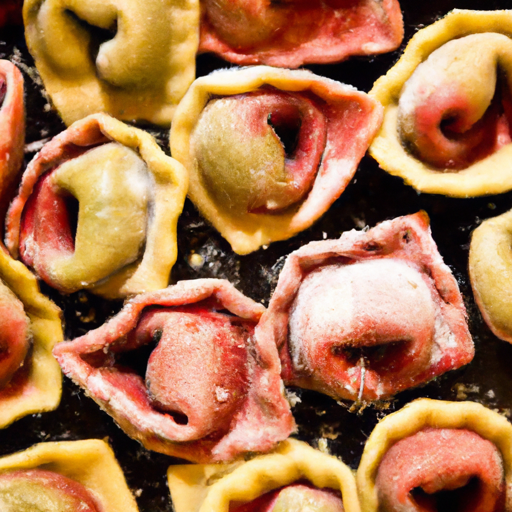Agnolotti Pasta: A Delicate and Delectable Italian Delight
When it comes to Italian pasta, there is no shortage of delightful variations to explore. One such pasta that deserves a special place on your culinary radar is agnolotti. These delectable little pockets of goodness are a true delight to the senses, with their rich taste, versatile nature, and fascinating history. Let’s dive right in and discover the world of agnolotti pasta!
Taste and Texture
Agnolotti is a type of stuffed pasta that hails from the Piedmont region in Italy. These small, pillow-like pasta dumplings are typically square or rectangular in shape, and they are renowned for their tender texture and rich, indulgent flavor. The dough is usually made with a combination of flour, eggs, and sometimes a hint of olive oil to create a smooth and elastic consistency. The filling, traditionally made with meats such as veal, pork, or beef, is minced and mixed with aromatic ingredients like Parmesan cheese, herbs, and spices, to add depth to every bite.
Versatile Culinary Uses
Agnolotti pasta has a knack for seamlessly adapting to a variety of culinary preparations, making it a beloved ingredient among chefs and home cooks alike. Whether you prefer a classic preparation or a more creative twist, agnolotti can be a star in many Italian dishes.
1. Classic Pairing: Agnolotti pasta is often tossed in a simple yet flavorful sauce, such as a sage and brown butter sauce, which perfectly complements the richness of the meat fillings. The combination of the subtly sweet pasta and the nutty notes of butter achieves an elegant harmony on the palate.
2. Light and Fresh: For a lighter and more refreshing approach, agnolotti can be served with a delicate tomato-based sauce or tossed with fresh herbs and a drizzle of olive oil. This option showcases the flavor of the pasta while allowing the filling to shine.
3. Indulgent Indulgence: If you’re feeling particularly indulgent, agnolotti can be baked with a luscious cheese sauce or layered in a lasagna-style dish. These preparations take the pasta to new heights of comfort and decadence.
Nutritional Value
Pasta, in general, is a valuable source of carbohydrates, providing the body with essential energy. Agnolotti, however, being a stuffed pasta, has a slightly different nutritional profile due to its filling. The meat-based filling adds a protein boost to the dish, making it more satiating and filling. The exact nutritional content can vary depending on the specific ingredients and proportions used in each batch, so it’s always a good idea to check the packaging or consult a recipe for precise information.
Agnolotti’s Fascinating History and Fun Facts
Like many beloved dishes, agnolotti has an intriguing story to tell. According to legend, its creation is credited to a cook from the Monferrato region, who was inspired by the shape of the priest’s hat (“agnus dei” in local dialect) to create this unique pasta. Traditionally, agnolotti was prepared during special occasions and family gatherings, bringing people together to savor its sumptuous flavors.
Interestingly, agnolotti is often associated with the celebration of Christmas and Easter in Piedmont. Families gather around the table to enjoy a meal featuring these delectable delicacies, showcasing the importance of food and tradition in Italian culture.
Experience the Elegance of Agnolotti
Agnolotti pasta is a celebration of the artistry and passion that goes into Italian cuisine. Its delicate texture, rich flavors, and adaptability make it a standout choice for anyone looking to create a memorable dining experience. Whether served as a comforting dish on a chilly evening or elegantly plated for a special occasion, agnolotti brings a touch of Italian finesse to the table.
So, why not embark on a culinary adventure and experiment with agnolotti? Get creative with your fillings and sauces or explore traditional recipes to savor the true essence of this Italian delight. Buon appetito!
Agnolotti Pasta
Origin: Agnolotti is a type of pasta that originated in the Piedmont region of northern Italy. It is believed to have been created in the 18th century in the city of Turin.
Common uses: Agnolotti pasta is traditionally filled with a variety of ingredients like meat, vegetable puree, cheese, or a combination of these ingredients. It is typically served in a sauce, such as a butter and sage sauce or a tomato sauce. However, there are many variations and regional adaptations of agnolotti fillings and sauces.
Nutritional benefits: The nutritional benefits of agnolotti pasta are mainly dependent on the filling and sauce used. As a pasta, agnolotti provides a source of carbohydrates, which are a primary source of energy. The filling ingredients, such as vegetables or lean meats, can add nutritional value by providing vitamins, minerals, and protein. The sauce can contribute to the overall flavor and nutritional content of the dish.
Unique properties or historical significance: Agnolotti is known for its unique shape and preparation method. It is made by folding pasta dough over a filling and sealing it, resulting in small rectangular or semicircular parcels. This creates a distinctive shape that sets agnolotti apart from other stuffed pasta varieties, like ravioli. Historically, agnolotti was a popular dish in Piedmont, and it was often served during special occasions and holidays. Today, it is enjoyed both in homemade preparations and in restaurants around the world. The name “agnolotti” is thought to have originated from the word “agnus,” meaning “lamb” in Latin, possibly reflecting the traditional filling of minced meat.




Use the share button below if you liked it.
It makes me smile, when I see it.